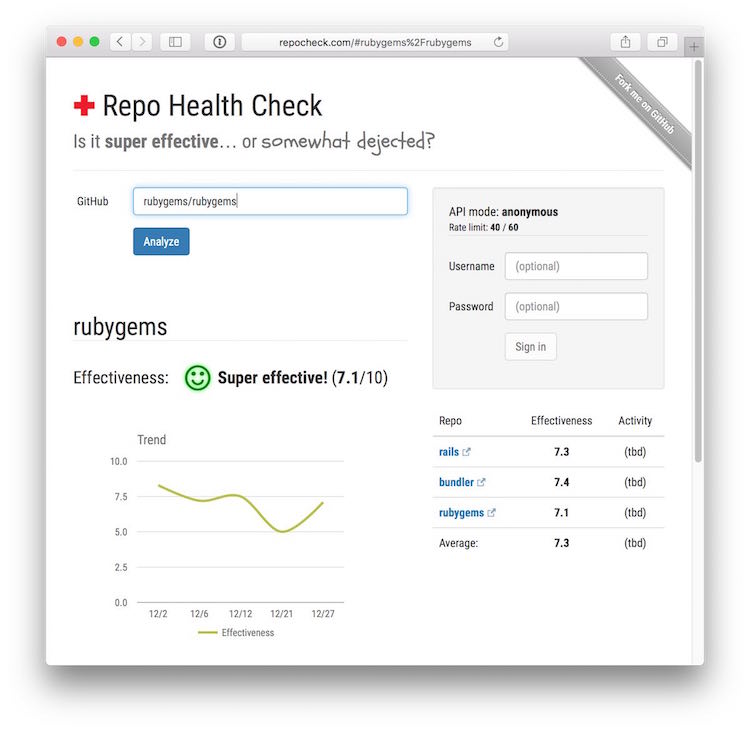Ecosyste.ms: Awesome
An open API service indexing awesome lists of open source software.
https://github.com/dogweather/repo-health-check
Analyze a project: How are the maintainers doing?
https://github.com/dogweather/repo-health-check
Last synced: about 1 month ago
JSON representation
Analyze a project: How are the maintainers doing?
- Host: GitHub
- URL: https://github.com/dogweather/repo-health-check
- Owner: dogweather
- License: apache-2.0
- Created: 2015-03-18T20:52:00.000Z (almost 10 years ago)
- Default Branch: master
- Last Pushed: 2024-06-07T19:00:31.000Z (9 months ago)
- Last Synced: 2025-01-03T01:40:37.180Z (about 2 months ago)
- Language: CoffeeScript
- Homepage: https://repocheck.com
- Size: 903 KB
- Stars: 79
- Watchers: 4
- Forks: 3
- Open Issues: 15
-
Metadata Files:
- Readme: README.md
- License: LICENSE
Awesome Lists containing this project
- awesome-ospo - Repo Health Check - Analyze a project: How are the maintainers doing? (Project Quality)
README
# Repo Health Check
Analyze a project and its management

[Live app →](https://repocheck.com/)
A fully client-side GitHub/BitBucket repo analyzer. It finds out: Is a
project well managed? Does it _accept help_? How does it compare to other
options? And then: what should you do to take your repo from **in the weeds** to
**_super effective_**?
It performs the hard work entirely in the browser so that each user's own API
rate limits are in effect. This avoids [problems similar projects](https://github.com/hstove/issue_stats/issues/10#issuecomment-58444422) have had, and means faster and more varied results.
## Use Cases
* **A developer looking for a library** wants to compare management styles of a few alternatives.
* **A developer thinking about contributing** to a project wants to know if it's worth it.
* **A job candidate wants to know** how a prospective employer manages their projects.
* **A company** wants to see if all its projects are being managed similarly.
## Development Status
One metric is implemented (**effectiveness**) and I'm brainstorming about next steps:
* More metrics
* Advice for improving the issues found
* New visualizations, and better UX
## Automated Signals
Quantitative measurements which can determine _qualitative_ assessments.
* Num. of active branches
* merged
* un-merged
* Num. of stale branches
* merged
* un-merged
* Num. of open pull requests
* proportion open:closed pull requests
* aging of pull requests
* Num. of open issues
* proportion open:closed issues
* Num. of stars
* Num. of forks
* Num. of subscribers
* ratio of # of tags to # of tags in use
### Intermediate Metrics
By using the raw signals listed above, we can calculate useful metrics. These metrics, then, will be the pieces that can form a judgement for the big questions.
E.g.:
* How well do the maintainers keep up with the queue of incoming PR's?
* How quick do the maintainers respond to new issues and PR's?
* How does the activity level affect the other metrics?
### Other sources
* Code Climate score
* Travis CI passing
### See Also
* https://www.quora.com/If-a-GitHub-project-has-a-lot-of-forks-what-are-some-guidelines-for-choosing-the-right-one
### Useful Tech
* [Hello.js OAuth](http://adodson.com/hello.js/)
## Similar Projects
* https://repohealth.info / https://github.com/pelson/repohealth.info
* https://github.com/cfjedimaster/githubhealth
* https://github.com/hstove/issue_stats
* https://github.com/ryo-ma/github-profile-trophy